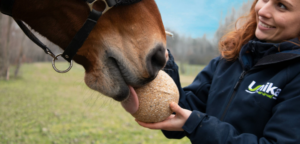
UNIKA BALLS: THE SUPPLEMENT THAT COMBINES FUN AND WELL-BEING
If you have ever walked through the stables or along…
Feed and products in 25kg bags excluded
Bank transfer | Paypal | Credit cards

The horse, as a grazing herbivore, has evolved and adapted over the years to an almost exclusively fibrous diet. The intestine of the horse is in fact a particularly developed organ, able to ferment the fibres introduced into the diet and obtain from these the energy necessary to satisfy the energy needs of the animal. However, the modern management of the horse, coupled with the ever-increasing performances that are required, have radically changed its eating habits: together with being in the stables, In fact, the continued availability of fibrous food has disappeared and part of the feed ration has been replaced by concentrated food, consisting of cereals of various kinds or feed. This disruption in the horse’s diet has led to an increase in the proportion of carbohydrates in the diet, particularly rich in cereals

Carbohydrates can be divided into structural carbohydrates (NDF), which basically include fibre, and non-structural carbohydrates (NSC), which include substances such as simple sugars, such as glucose, and polysaccharides, like starch and fructans.
As said, the horse during its evolutionary history has never been able to adapt to such high levels of carbohydrates, especially non-structural, that for this reason can cause digestive and metabolic changes within the animal that in turn can lead to even serious pathological conditions. In fact, there is a heterogeneous group of diseases called “Horse diseases associated with carbohydrates“, a term that unmistakably clarifies the dietary origin of such diseases.
Il The horse is able to use carbohydrates only after splitting them into their simplest units, called monosaccharides: this process, known as digestion, takes place by digestive enzymes such as amylase, produced by the pancreas and poured into the intestine. However, the production of amylase in the horse is reduced, which is why some of the non-structural carbohydrates arrive undigested in the large intestine, where the intestinal bacterial flora ferments them. The fermentation products of non-structural carbohydrates include substances such as carbon dioxide and lactic acid. The first substance is a gas that determines in the horse an annoying and sometimes painful dilation of the intestine with the appearance of meteorism, while the second substance is able to lower the intestinal pH, thus creating a more acidic environment than normal physiological conditions. The alteration of the enteric environment determines the onset of an intestinal dysbiosis, in which the abundance of fermentative microorganisms of the fibre decreases, thus decreasing the ability to digest the fibre, and instead increases that of lactic acid producing microorganisms further aggravating the situation and creating a vicious circle.
The production of lactic acid in the intestine can also lead to metabolic acidosis, the appearance of loss of appetite, irritation of the intestinal mucosa, diarrhoea, colic and laminitis. It is also not uncommon to observe in the horse an alteration of his behaviour, which generally becomes more snowy and less tolerant to physical exertion.

Another aspect to consider is the fact that non-structural carbohydrates once cleaved into their simplest units, the monosaccharides, are quickly absorbed by the intestine and poured into the blood, causing blood sugar to rise. In particular, the greater the amount of non-structural carbohydrates that the horse ingests, such as in diets rich in cereals, the greater the glycaemic peak. The body of the horse to respond to this sudden increase in blood sugar increases the production of insulin, a hormone produced by the pancreas whose task is to promote the distribution of sugars in the tissues for their use.
The high production of insulin in response to high glycaemic peaks, if prolonged over time, leads to a lower sensitivity of the cells to insulin itself, thus making the transport of sugar from blood to tissues less effective. This creates the so-called “insulin resistance” that forces the pancreas to produce more insulin in order to maintain a physiological glycemia. Insulin resistance is a predisposing factor to the onset of colic, stress myopathies and accumulation of adiposity and is one of the clinical signs of Equine Metabolic Syndrome. onentedi coliche, mitabolica Equina.

Concentrated foods are an important source of energy for horses, especially when engaged in competitive activities, which is why it is essential to choose them carefully. Among cereals, oats are the most easily digestible and tolerated by horses, while maize is the cereal with the highest amount of indigestible starch, which is why it should be strongly limited. As regards to feeding stuffs, however, in addition to the raw materials with which they are formulated, it is useful to evaluate their fat content and physical fitness. Let’s proceed in order:

Importantly, hay can also be rich in non-structural carbohydrates, such as sugars, starch, and fructans. For this reason, it is important to pay particular attention to the quality of hay, the main food of every horse. We will go into this in more detail in the next articles.
Other suggestions to follow always, able to normalize the glycaemic response of the horse are the following:

If you have ever walked through the stables or along…

Colic is one of the most common and delicate issues in horse care.

Thanks to its anti-inflammatory, anti-oedemigenous and pain-relieving properties, it is perfect for protecting horses’ osteoarticular well-being.

The use of clay dates back to very ancient times and even today it has not lost its fame as a natural remedy with a thousand uses.

The warm season is upon us and for many riders it is time to take the clipper in hand…

Here we are at our second meeting with our Unika Blog Naturopathy section. I am Sara Maiani, specialized in Natural Medicine, Clinical Phytotherapy and Naturopathy.